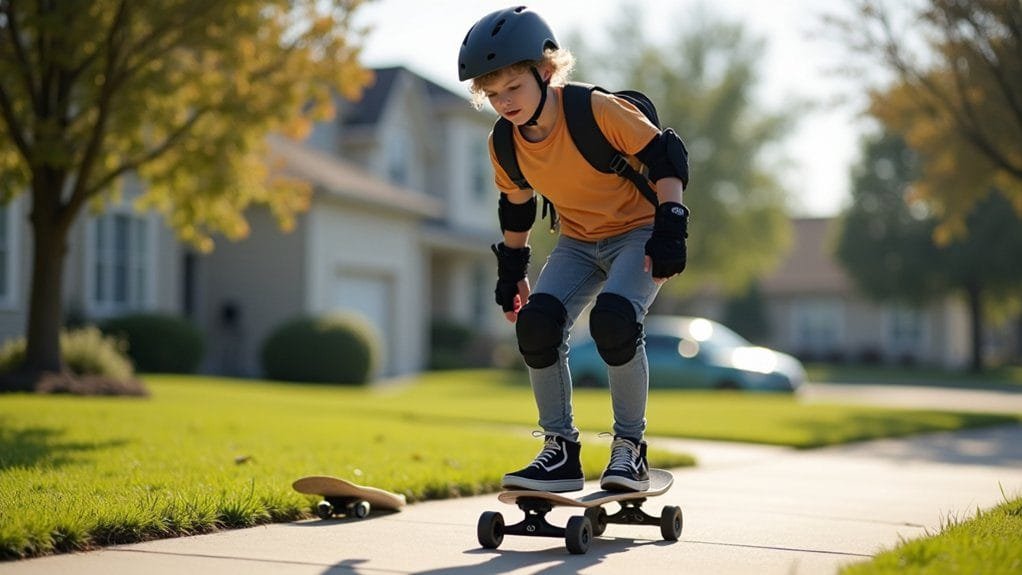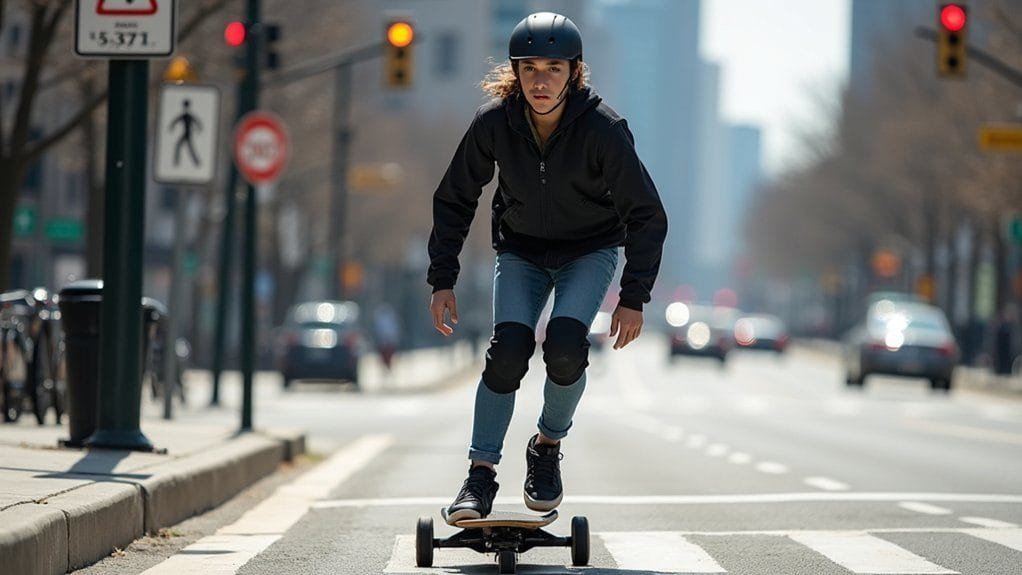Electric skateboards can be safe for beginners if you prioritize proper safety gear, controlled learning environments, and methodical skill development. You’ll need a quality helmet, protective pads, and strategic practice in open spaces. Start with lower speeds, master balance techniques, and understand your board’s mechanics. Familiarize yourself with local regulations and choose a beginner-friendly board with stable design. Your journey toward confident riding begins with calculated, incremental progress.
Key Takeaways
- Electric skateboards can be safe for beginners when proper safety gear, including helmets and protective pads, is consistently used.
- Comprehensive learning and gradual skill development in controlled environments significantly reduce the risk of accidents for new riders.
- Choosing a beginner-friendly electric skateboard with moderate motor power and stable deck design enhances initial riding safety and confidence.
- Understanding and adhering to local regulations regarding speed limits, riding zones, and age restrictions is crucial for safe operation.
- Consistent practice, body control techniques, and maintaining a cautious approach help novice riders minimize potential risks and improve overall safety.
Understanding Electric Skateboard Risks


While electric skateboards offer an exciting mode of transportation, they come with inherent risks that riders must carefully evaluate. When riding an electric skateboard, your control and stability can be quickly compromised by high speeds, especially for novice riders. The potential for accidents increases dramatically without proper preparation and awareness of environmental challenges like wet surfaces or uneven terrain.
Experienced riders understand that peace of mind comes from methodical skill development and protective gear. Wearing a helmet is non-negotiable, as head trauma remains a significant risk. Battery integrity, balance techniques, and understanding your electric skateboard’s unique handling characteristics are critical for safe navigation. By acknowledging these risks and systematically addressing them, you’ll minimize potential injury and maximize your riding experience.
Essential Safety Gear for New Riders
Recognizing the potential hazards of electric skateboarding underscores the paramount importance of thorough safety gear. You’ll want to prioritize a high-quality helmet, which can reduce head trauma risk by up to 85%. Complementing this, knee and elbow pads are critical for protecting vulnerable joints during potential falls. Wrist guards are particularly essential, mitigating the likelihood of fractures that frequently occur during impacts.
Your protective ensemble should also include bright or reflective clothing to enhance visibility, especially in low-light conditions. This strategic approach considerably reduces accident risks by making you more noticeable to surrounding traffic. Investing in safety equipment that meets established standards guarantees peak protection and comfort, enabling you to ride with increased confidence and reduced vulnerability to potential injuries.
Learning to Ride: Techniques and Strategies


As you commence your electric skateboards journey, mastering fundamental riding techniques becomes paramount to guaranteeing both safety and enjoyment. Control and balance at high speeds depend on precise body mechanics and strategic practice.
Embrace electric skateboarding with purposeful technique, transforming body mechanics into fluid motion and confident control.
Key visualization techniques include:
- Imagine an empty parking lot transforming into your personal skills laboratory
- Visualize your body as a fluid mechanism adapting to board movement
- Picture yourself executing smooth, calculated turns with minimal effort
Lean your body weight strategically to manage acceleration and deceleration. Practice turning by applying foot pressure and shifting weight deliberately. Start with gradual increases in speed, maintaining a shoulder-width stance to optimize stability. Wearing the right gear enhances your riding experience and helps you stay safe while developing confidence. Methodical, incremental skill-building guarantees you’ll progress from novice to competent rider efficiently.
Choosing the Right Electric Skateboard for Beginners
After mastering initial riding techniques, selecting the appropriate electric skateboard becomes the next strategic step in your electric skateboarding journey. When choosing the right board, focus on key technical specifications that guarantee stability and control. Look for a good electric skateboard with 500W to 1000W motor power, providing balanced performance for beginners. A drop-through deck design lowers your center of gravity, enhancing overall stability during rides. Prioritize models with hub motors for quieter operation and reduced maintenance requirements. Evaluate the remote control’s functionality, guaranteeing intuitive braking systems that allow precise speed management. Battery life should exceed 10-15 miles to support extended riding sessions. Remember to wear the right pieces of protective gear and select a board that matches your skill level and riding objectives.
Local Regulations and Riding Guidelines


While traversing the world of electric skateboarding, understanding local regulations becomes paramount to ensuring a safe and legal riding experience. Electric skateboarders must meticulously investigate local guidelines to maintain compliance and safety.
Key considerations include:
- Verify specific speed limits (typically 15-20 mph) that govern electric skateboard operation
- Confirm age restrictions and required protective gear for legal riding
- Research permitted riding zones, including sidewalk and street access restrictions
Precise adherence to local regulations protects both riders and pedestrians. Checking municipal ordinances before commencing your electric skateboard journey prevents potential legal complications. Protective gear, particularly helmets, and understanding age-related restrictions are critical components of responsible riding. Remain vigilant about evolving regulations, as urban mobility laws continuously adapt to emerging transportation technologies.
Maintenance and Equipment Checks
Because maintaining your electric skateboard is fundamental to its longevity and performance, riders must adopt a systematic approach to equipment checks and maintenance. Regular inspections of wheels, motors, and battery components are critical for guaranteeing safety during riding.
| Maintenance Task | Frequency |
|---|---|
| Wheel Check | Before Each Ride |
| Battery Inspection | Monthly |
| Bearing Lubrication | Every 3 Months |
| Thorough Equipment Audit | Quarterly |
Performing meticulous safety checks involves verifying wheel nut tightness, examining truck integrity, and evaluating overall equipment condition. Focus on detecting early signs of wear, rust, or potential mechanical failures. By conducting periodic maintenance, you’ll optimize your electric skateboard’s performance and minimize unexpected malfunctions. Prioritize following manufacturer guidelines for battery care, wheel replacement, and bearing maintenance to extend your skateboard’s operational lifespan and guarantee a reliable riding experience.
Common Riding Scenarios and Prevention
When maneuvering the dynamic landscape of electric skateboarding, riders must proactively anticipate and mitigate potential challenges inherent in various riding scenarios. You’ll want to keep an eye on your environment to prevent accidents that can still occur, especially when higher speeds increase risk.
Key scenario prevention strategies include:
- Utilizing bike lanes and yield to pedestrians to minimize collision potential
- Equipping your electric skateboard with built-in lights for enhanced visibility during low-light conditions
- Selecting smooth, flat surfaces that provide stable riding conditions similar to a regular skateboard
Building Confidence and Skill Progression
Mastering electric skateboards requires a systematic approach to skill development. When electric skateboards come into your learning process, you’ll want to ride in safe, open areas like empty parking lots to keep your feet stable and focused. Start slow, gradually increasing speed to build confidence in your balance and control. Safety gear isn’t just protective—it’s a critical component of skill progression, encouraging calculated risk-taking as you improve.
Consistent practice is key. Begin by developing muscle memory through repetitive turning and maneuvering exercises. Electric skateboards offer an advantage for beginners, eliminating the need for pushing and allowing you to concentrate on steering techniques. By methodically breaking down skills and practicing deliberately, you’ll transform from a novice rider to a confident electric skateboard enthusiast.
Frequently Asked Questions
Is an Electric Skateboard Easy to Learn?
You’ll find electric skateboarding’s learning curve smooth with basic balance skills, proper safety gear, and mastering acceleration control. Practice braking techniques on flat terrain, maintain good riding posture, and gradually build confidence in designated practice areas.
Can a 12 Year Old Ride an Electric Skateboard?
A 12-year-old can ride an electric skateboard with proper safety guidelines, protective gear, parental supervision, and consideration of weight limits, local laws, and riding techniques for beginners.
Which Type of Skateboard Is Best for Beginners?
You’ll find longboards with bamboo decks, 90mm wheels, and reverse kingpin trucks ideal for beginners. Consider entry-level electric models with 500-1000W power, prioritizing safety gear, weight limits, terrain compatibility, and reliable brands within your budget.
Can You Ride an Electric Skateboard Normally?
You can ride an electric skateboard manually, but it’s like pedaling a stationary bike uphill—challenging! You’ll need balance, safety gear, and patience to navigate different terrains while managing the board’s heavier weight and reduced efficiency.
Which Electric Skateboard Would Be Safer for a Beginner: Boosted or Meepo?
When choosing between Boosted and Meepo for beginners, safety is a crucial factor. Boosted boards are known for their stability, making them a safer option. However, Meepo boards often provide better value, particularly for urban commuting. Consider these two brands among the best electric skateboards for commuting to find your perfect match.
Conclusion
Electric skateboarding isn’t just a skill—it’s an epic journey of mastery. You’ll transform from a tentative beginner to a confident rider through systematic learning, rigorous safety practices, and progressive skill development. By meticulously implementing proper techniques, investing in quality protective gear, and understanding technical nuances, you’ll minimize risks and maximize your riding potential. Your dedication will turn potential hazards into exhilarating experiences of personal achievement.
